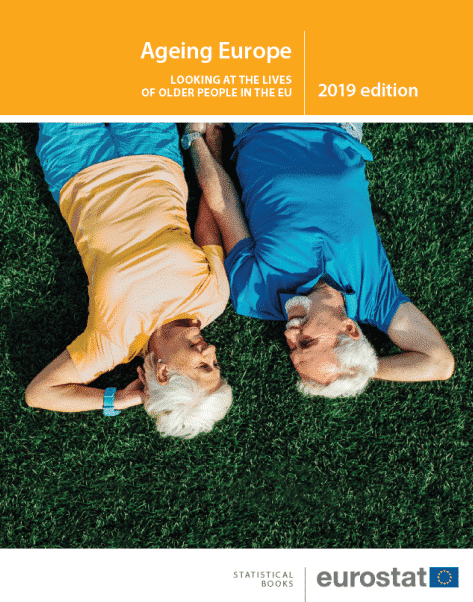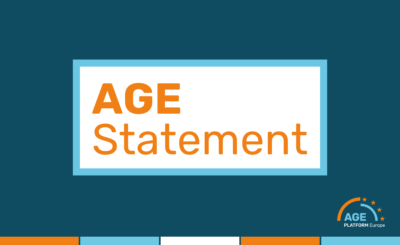
The publication includes 6 chapters which look at:
Population developments in EU member states – chapter 1
In early 2018 there were 101.1 million older people (aged 65 years or more) living in the 28 EU countries, which is almost one fifth (19.7 %) of the total population. During the next three decades, this figure is projected to rise up to 149.2 million inhabitants in 2050 (28.5 % of the total population).
This rapid ageing of the EU population results primarily from a long-term fall in fertility rates and increased life expectancy (longevity), mainly due to health and medical progress and improved living and working conditions.
A few figures picked up from the report:
- The median age within the EU is expected to increase by 3.8 years by 2050.
- The number of very old people (aged 85 years or more) is expending rapidly, with more than twice as many very old women as very old men. However, the share of very old men was generally rising at a faster pace than the share of very old women.
- Older people accounted for a high share of the population in eastern Germany and northern Italy.
- In the timespan of 50 years, the old-age dependency ratio – the ratio between the number of persons aged 65 and over and the number of persons aged between 15 and 64 (‘of working age’) – is projected to more than double.
(data collected in 2018)
Housing and living conditions for older people – chapter 2
The geographical localization and type of household in which older people live may also determine their quality of life, risk of poverty, or the services that they require.
Some of the facts pointed out by Eurostat:
- A relatively high share of older people in the EU lives in rural areas. This geographical distribution is to be taken into account by policymakers when assessing access to various services for older people.
- Older women are generally more likely (than older men) to face severe difficulties in being able to pay for basic goods and services.
- The growing number of older people (in particular older women) living alone is particularly worrying.
- Approximately half of all older people were living in under-occupied dwellings (i.e. that are too large for their needs).
(data collected in 2017-2018)
Health and disability – chapter 3
Health is an important measure of well-being, in particular for older people as it is an important factor for personal independence and participation in local communities.
A significant increase in demand for long-term care is to be expected and services covering diseases that typically affect older people (e.g. arthritis, mental health/ dementia, sensory impairment).
Some of the trends highlighted:
- About half of older people (aged 65-74 years) in the EU-28 perceive their health to be good or very good, a share that fell close to one third (34.1 %) among those aged 75-84 years and to one quarter (25.0 %) for very old people (aged 85 years or more).
- Older people with high incomes are more likely to perceive their own health as good or very good.
- Almost 3/4 of people aged 85 years or more have a long-standing health problem.
- The most common chronic diseases reported by older people are: high blood pressure, arthrosis and back problems.
- Diseases of the circulatory system are the most common cause of death among people aged 75 years or more (while cancer is the main cause of death both for men and for women between the ages of 55 and 74 years).
- Almost 1/3 of people aged 75 years or more experience severe difficulties in walking, while close to one tenth of people aged 65-74 years face this limitation.
- 1/5 of women aged 75 years or more make use of homecare services. It is here also worth considering that while some older people receive homecare services, others are providers of similar services – for example, looking after other elderly people or looking after grandchildren (see chapter 6).
- A relatively high share of people aged 75 years or more reports depressive symptoms. Yet, here again, data in chapter 6 reveal that older people across the EU-28 were generally more satisfied with their lives than the general adult population).
- Older people tend to eat more fresh fruit and vegetables than the average population and are less likely to be daily smokers, but they are more likely than average to be obese (except for the very old people)
- More than 1/10 of people aged 75 years or more report severe difficulties preparing meals.
(data collected in 2014-2017)
Transition from work into retirement – chapter 4
In the EU more and more people aged 55-64 years have been active on the labour market during the last three decades, with a particular sharp increase observed since 2003. Improving work-life balance becomes particularly relevant to older workers: a growing number benefit from flexible working conditions that allow them to work longer, increasing their income and reducing their need for government support.
Financial considerations, health status and family commitments often play a role when older people consider the optimal date for their retirement.
Some figures:
- People aged 55 years or more accounted for almost one fifth of the total workforce.
- More than half of the workforce aged 65 years or more was employed on a part-time basis.
- More than 2/5 of the workforce aged 65-74 years were self-employed.
- 1/7 of the workforce aged 65 years or more usually worked from home.
- The average duration of a man’s working life was 4.9 years higher than that of a woman.
- Older people were more likely to be satisfied at work (around 94%)
(data collected in 2016-2018)
Pensions, income, and expenditure – chapter 5
Projections show that there will be more and more pensioners, but fewer workers to finance them.
The ageing of the population has also an impact on the way we spend our money: when getting older people tend to spend more on health, food and their home, and less on transport and clothes.
Regarding income, older Europeans are often found to have a lower risk of poverty than other age groups, however:
- almost 10 % of older people in work are at risk of poverty
- more than 1/3 of all older people living alone was unable to face unexpected financial expenses
- older women experience a higher risk of poverty and are more frequently reliant on income provided by their partner.
(data collected in 2015-2018)
Social life and opinions of older people – chapter 6
Overall, older people have higher levels of life satisfaction (compared with other age groups) in several western and northern EU Member States. The main factors that influence their well being are:
- health
- participation in diverse activities (e.g. returning to education, taking up a hobby, carrying out volunteer work, travelling or playing sports) – this is very much linked to the health status of the person.
- regular contacts with family and/or friends
Some figures:
- 1/3 of people aged 75 years or more spent at least three hours per week on physical activity.
- More than 1/3 of people aged 75 years or more participated in cultural/ sporting events.
- Approximately 1 in 15 people aged 55-64 years participated in education and training.
- 2/5 of people aged 65-74 years had never used a computer.
- Almost 1/3 of people aged 65-74 years made online purchases
- Less than half of all people aged 65 years or more participated in tourism
- More than 1/5 of people aged 65-74 years participate in formal voluntary activities and 1/4 of women aged 65-74 years participate in informal voluntary (helping other people including family members not living in the same household).
- Women are more likely than men to have regular daily contact with their family and relatives: 30 % of women aged 65-74 versus just above 20 % men of the same age).
- The greatest burden of providing care to both grandchildren and older relatives with a disability fell on people aged 50-64 years, mostly women.
(data collected in 2015-2018
Download the full publication on Eurostat website
Eurostat data on ageing are also presented in a more interactive tool here, which provides statistics per domain and per country (you can select your country).






